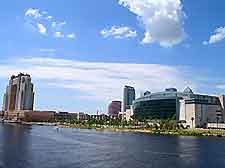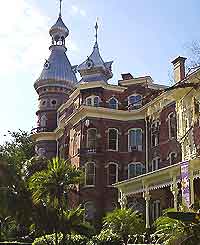Tampa History Facts and Timeline
(Tampa, Florida - FL, USA)

Although there is little information about Tampa's native population prior to European contact, this southwestern Florida city's name comes from the Calusa word 'tanpa', which loosely translates to 'sticks of fire' in English.
The Calusa were the dominant tribe in southern Tampa Bay, while Tocobaga villages encircled the northern region.
History of Spanish Exploration
In 1521, Spanish explorer Juan Ponce de Leon began his fountain of youth quest south of Tampa Bay, while Hernando de Soto, another Spanish conquistador, searched for gold here in 1539. After both treasures proved elusive and native populations declined, the area remained largely uninhabited for two centuries. Spanish mapmakers first described the region as 'Tampa' in around 1695, but a Dutch cartographer officially named the area Hillsborough in 1772.
Permanent Settlement
The permanent history of Tampa really began in 1824 when the US Army established Fort Brooke, the area's first permanent settlement. The city's modern Convention Center now stands on this very spot. Fort Brooke, originally built to protect residents against Seminole uprisings, became a thriving frontier outpost and trading post. In 1855, Tampa was officially incorporated as a town, but the population of its surrounding Hillsborough County remained under 900.
Railroads and Cigars
The town experienced its first population boom after Henry B. Plant brought a rail line here in 1884 and opened the lavish Tampa Bay Hotel in 1891. The former hotel is now part of the University of Tampa. Spanish American War soldiers were among the passengers aboard Plant's steamship line to
Key West and
Havana, which opened in 1887.
The cigar factory that exiled Cuban manufacturer Vicente Martinez Ybor opened in 1885, on the eastern side of Tampa, attracted workers not only from
Cuba, but from throughout Europe. Ybor City, as the world's cigar capital was officially known, comprised some 200 cigar factories, employing almost 12,000 people at its peak.
Although Fidel Castro's government and the United States Cuban tobacco embargo ended Ybor City's cigar production, the area remains a National Historic Landmark and is today loaded with nightclubs, shops and art galleries, all housed within historic buildings.

Organized Crime
In 1904, a group of local businessmen formed a fake gang named after the famous local pirate Jose Gaspar and pretended to invade the city. Each January, Tampa continues this tradition during the Gasparilla Pirate Festival. However, not all gangs were so harmless.
During the early 1920s, Charlie Wall took over the illegal bolita lotteries held among the working classes since the late 19th century. Several law enforcement officials and local politicians were involved in the operation, with control falling under mafia boss Santo Trafficante and his son in the 1950s. These illegal operations finally ended after the trials of several prominent local officials at the end of the 1950s.
Modern Times in the City
In 1914, the first regularly scheduled commercial flight soared from St. Petersburg to Tampa. The city became an important center for shipbuilding during both World Wars and the MacDill Air Force Base first opened during WWII. When Lowry Park and the Busch Gardens, two of the city's most popular tourist attractions, opened during the 1950s and the 1960s, the city enjoyed the most dramatic population growth in Tampa history.
Today, the thriving Hispanic population has helped the city to become one of the United States' top five most diverse urban regions. The erupting water and fire sculpture in front of the modern Tampa Convention Center, where Fort Brooke once stood, pays tribute to the city's original history and roots.
 Although there is little information about Tampa's native population prior to European contact, this southwestern Florida city's name comes from the Calusa word 'tanpa', which loosely translates to 'sticks of fire' in English.
Although there is little information about Tampa's native population prior to European contact, this southwestern Florida city's name comes from the Calusa word 'tanpa', which loosely translates to 'sticks of fire' in English.